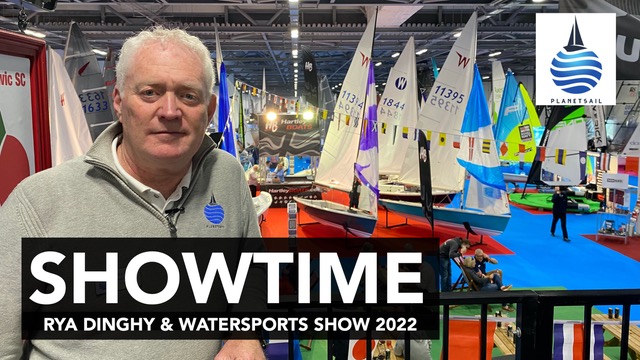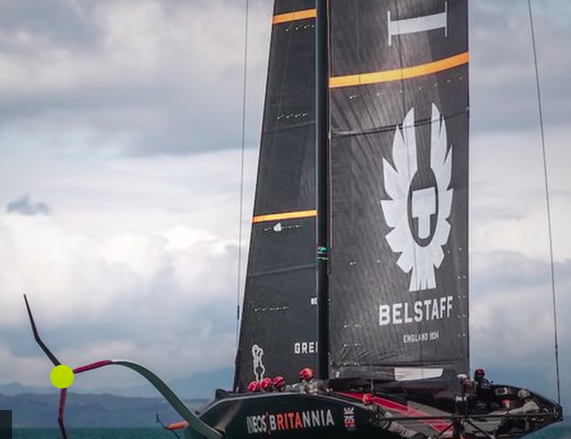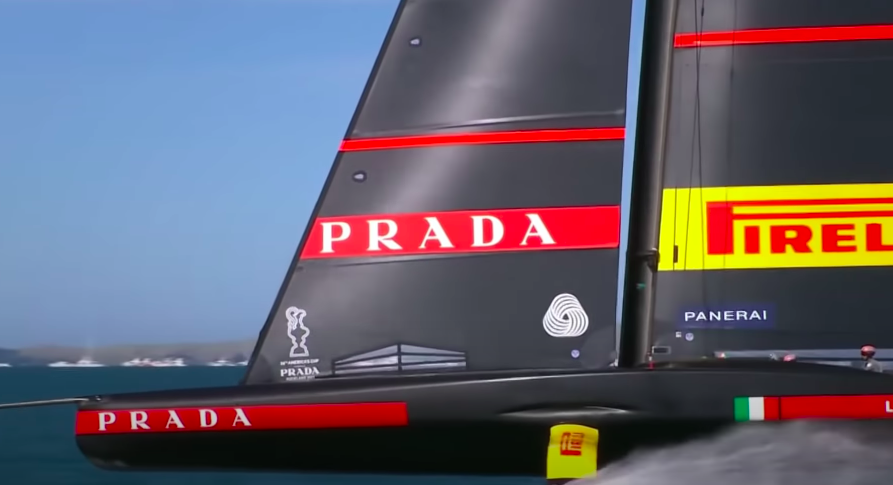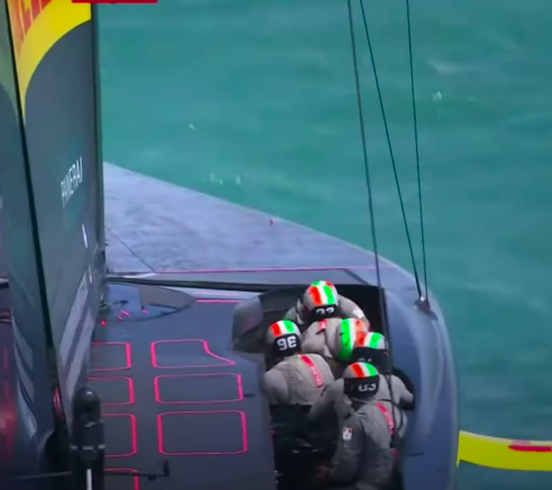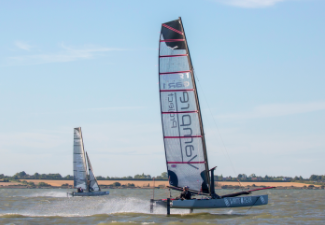
In 2017 the Vampire Project could claim, with only a slight smile, to be leading the world in developing the canted T foil system chosen for the 2021 America’s Cup. We had already worked on the concept for three years after seeing the limitations of the L foil system on C Class catamarans. By 2017 we had two boats on the water and were winning races. In early 2018 we hosted three members of the Ineos team at our training camp in Spain to help their testing programme.
Millions of dollars have now been invested and the America’s cup teams have little to learn from us. The technology has been refined by some of the world’s best talent and although the straight-line speeds are no faster than we would expect from a bigger boat, the smooth tacking and gybing is at a level we can only dream of.
This article is written for two reasons. First to provide some insights which have been missed by the press and expert commentators. Second to list some “unanswered questions” intended to generate debate. I hope to glean some useful input for the Vampire project, which remains open book and Corinthian in nature – no secrets.
Canted T Foils

The Vampire has the same foil setup as the AC75s, and its foiling behaviour is notably similar. It sails with a canted T foil to leeward with the windward foil raised. It controls lift with flaps on the main foil. The Vampire and AC75 have similarities to the 11’ international moth except that the rudders and main foil are not in line, something that causes a few problems as we will see below.
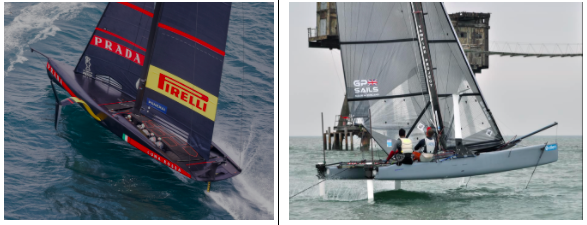
There are of course differences: the Vampire foils are attached to a 20ft catamaran rather than a monohull – the number of hulls isn’t important once the boat is flying. The foils are retracted upwards rather than folding below the boat to allow easy launching and recovery from a beach or slipway. And it has two rudders rather than one1 which adds wetted surface but improves control. Overall the Vampire provides a stable and forgiving platform, whereas the AC75 is intended to be challenging to sail in every sense.
There are also smaller differences – the Vampire can increase righting moment using rudder differential2 and controls its flight height automatically with a variable length wand attached to the bow. It uses crew weight to provide significant righting moment changes. It has a single skinned mainsail rather than the more efficient but heavier double skin on the AC75. In addition it has a very flat spinnaker, a crushing advantage in light or marginal foiling winds but a disadvantage in breeze3.
Relative straight-line performance is almost exactly as we would expect. A bigger boat will be faster roughly in proportion to the square root of its length – an obvious over-simplification, but the point is that ‘size matters’. In the case of the AC75 we would expect to double the Vampire’s speed4, which is almost exactly what happens.
The Vampire lifts onto the foils at 10 knots compared to the AC75 at 20 knots.
Upwind speeds in the Vampire are 17-20 knots, on the AC75 30-40 knots.
Normal downwind speeds on the Vampire are 20-25 knots, on the AC75 35-50 knots.
The peak downwind speed on the Vampire is 35 knots – but we have yet to see 70 knots from the AC75s and cavitation problems may make it unachievable
American Magic Capsize
The commentary has been inspirational, but in the time available cannot dig deep enough to explain all that is going on. Some examples from the much-analysed American Magic capsize:
-A bear away immediately after a tack was always going to be risky, as pointed out by Paul Goodison at the time and picked up by the commentors. But we are not told why. Indeed the journalists (as opposed to the expert commentators) suggest that high speed caused the capsize when the problem was probably the opposite: the higher the speed before a bear away the safer it is because the apparent wind stays forward. If American Magic had given itself time to reach full speed before bearing away history might have been different.
-The failure to loosen the leeward running backstay was a major contributing factor. The obvious effect was to heel the boat. But it also moved the centre of effort towards the stern making it difficult for the boat to bear away. We can hear the helmsman complaining he has no rudder – with hindsight that is unsurprising.6
The biggest omission from the commentary is a proper explanation of the flyout – the way the boat leaps out of the water. We are just told that it gets out of control, clearly true but unhelpful.
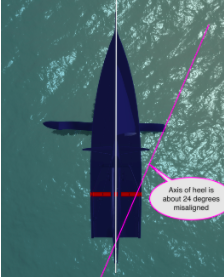
I think that the clue to the flyout lies in the misalignment between rudder and foil. The diagram above suggests that the axis between rudder and main foil is about 24 degrees off the centreline and this becomes the axis of heel – the line around which the boat pivots when it heels.
This off-centre axis of heel is important because it means that the leeward transom dips when the boat heels to leeward, and the angle of incidence of the main foil is increased. Heel = stern down = more lift from main foil = flyout.
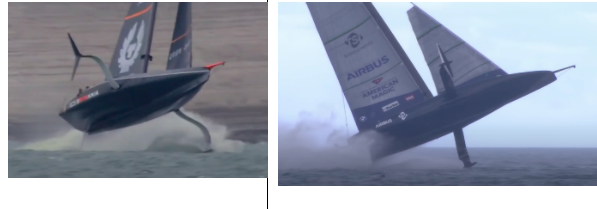
The photos above show how this happened to both American Magic and Ineos. I also show an old photo of the Vampire suffering the same problem. In all cases look at the leeward stern dipping which increases the angle of attack on the main foil and thus the lift.
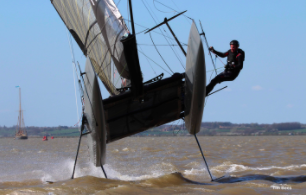
The implications are far reaching. For the AC72 the problem can be dealt with by keeping the boat upright at all times. Instability is built into the design so the flight controllers must compensate for any heel to windward or leeward heel because even small changes to the angle of attack of the foils will cause big changes to the amount of lift. Unexpected heel, as suffered by American Magic due to the running backstay, will cause a capsize, especially with such a small rudder. Not easy to sail.
I do not regard it as a major problem for the Vampire. Our two rudders add stability and the wand works automatically to regulate lift from the flap on the main foil. We have test sailed with one rudder at a time to see what happens. As expected foiling is fairly stable with just the leeward rudder because it nearly in line: but highly unstable with just the windward one. With both rudders down we have plenty of time to react and flyouts such as the one above are now a rarity. They mainly occur when we embarrassingly forget to release the wands from their shore position: we land heavily but safely on two hulls.
Unanswered questions for discussion
Why don’t the AC75s use their code zeros7?
There is considerable freedom to use large headsails in the AC75 rules. TNZ has tested a code zero extending from the masthead to the bowsprit (see below) but there has been no sign of any appearing in the competition even in the lightest of winds when the extra sail area must be tempting. I’m surprised by this – maybe there is a rule that makes it difficult to change. Or maybe we will see them later in the regatta.
This is a longstanding debate within the Vampire project. Some say that there is no point in sailing at all in sub-foiling conditions, so leave the spinnaker ashore: I believe that the boat has to be competitive throughout the wind range, even in displacement mode. We currently have both options – a pole that is quickly removed if the wind blows up. A super flat spinnaker which can be used up to 20 knots of downwind speed. At higher speeds it collapses and must be taken down.
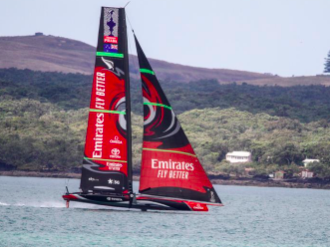
Why tolerate so much drag in pre-foiling conditions?
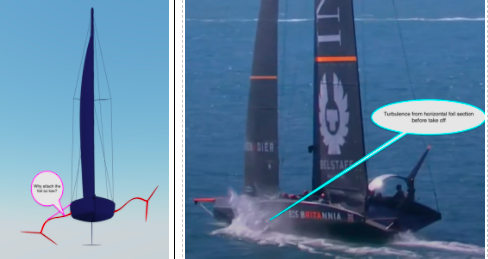
The AC75 foils are attached to the bottom corner of the hulls, creating drag in pre-foiling mode because the horizontal section of the foil skims the surface. This could be resolved by straightening the foil (cheaper to build) and attaching it to the top corner of the hull as per the Vampire. I am aware that the teams may be constrained by the one design nature of the foil arms but it is notable that some teams have managed to fix their foils higher than others.
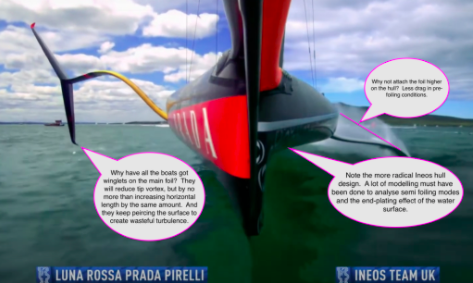
Why are there winglets at the end of the AC75 foils?
These are clearly intended to reduce tip vortex. But the leeward end keeps piercing the surface which is hydrodynamically inefficient. The same reduction in tip vortex could be achieved with a longer foil which would also be easier to build. I am aware that this may be optimised for the rules rather than performance, but I haven’t had time to digest the full 72 pages.
How do the AC75s raise their foils so smoothly?
This is a big question for those who have sailed the Vampires. We can easily foil gybe but there is a problem in raising the windward foil after the gybe. The foil adopts a semi submersed position and can only be raised with excellent timing and skill. Yet the AC75s raise their foils smoothly and without any apparent trouble. How?
Conclusion
It would be good to see the AC technology filtering into the world of normal sailing. AC75 racing requires deep water, tow boats, cranes and a massive budget, so it is unlikely to continue. Vampires can be sailed from a beach and offer a realistic development platform for the adventurous. Who knows what we will see when the Cup is over.
William Sunnucks
Go here for more on the The Vampire Project
